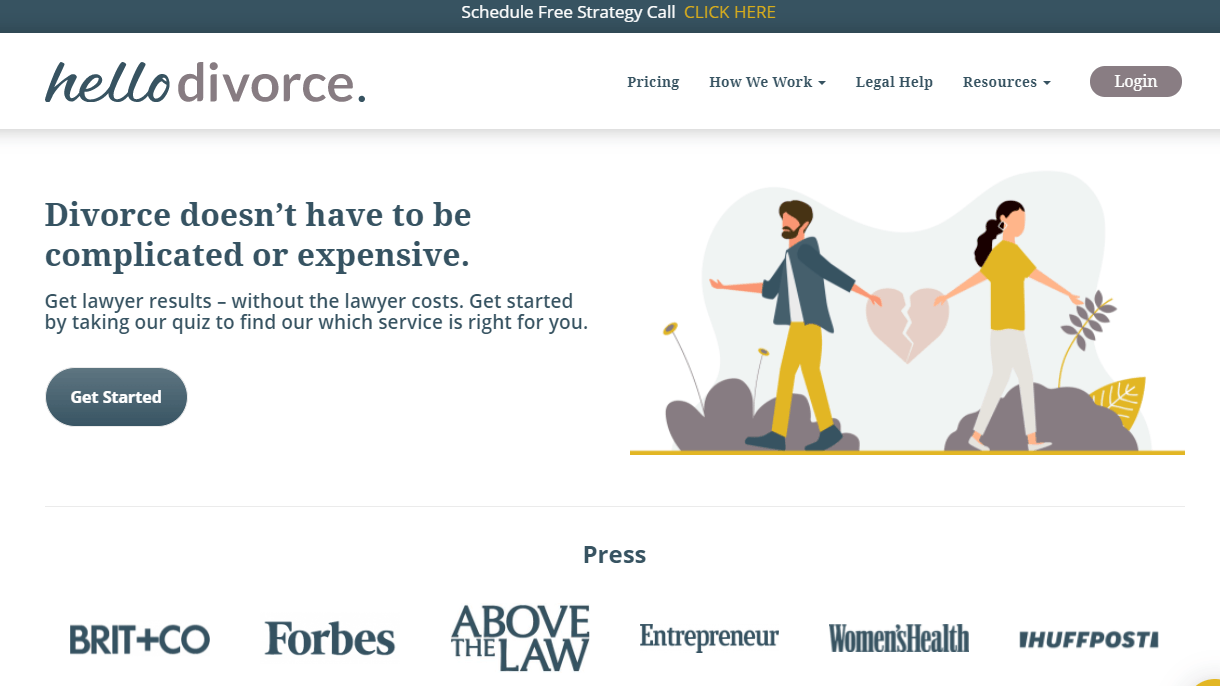Hello Divorce, a California startup whose platform facilitates low-cost do-it-yourself and attorney-assisted divorces, has raised a seed investment of $2 million to help fuel its expansion to all 50 states.
The investment was led by CEAS Investments, a single-family office that specializes in long-term investments in disruptive technologies.
Other investors included Jack Newton, cofounder and CEO of law practice management company Clio; Lightbank; Northwestern Mutual Future Ventures; Gaingels, a network of LGBT investors; Lisa Stone, WestRiver Group managing director and former founder and CEO of BlogHer; and EquityESQ, led by San Diego lawyer and investor Ed Diab.
This is the company’s first time raising outside funding, founder and CEO Erin Levine told me in a recent interview. She bootstrapped development of the initial platform and was able to fund early growth and development through the company’s own revenue.
“That put us in a unique position raising at the seed round in that we were already profitable and revenue generating,” Levine said. “We were already growing at a pretty good clip.”
Levine, a divorce attorney in Emeryville, Calif., started Hello Divorce in 2017 as part of her law firm and spun it off in 2018 as a platform for do-it-yourself divorces.
The site has earned several legal industry awards, including the American Bar Association’s 2020 James I. Keane Memorial Award for Excellence in eLawyering and Clio’s 2019 Reisman Award for legal innovation.
Last August, Levine announced plans to expand Hello Divorce from California to all 50 states. (See my LawNext interview with Levine and my blog post about the expansion.)
To date, Hello Divorce has expanded into three states, Colorado, Texas and Utah. The company says this new investment will help accelerate its expansion into additional states, starting with New York and Florida in the near future.
The goal is to be operating in 12 states within two years, which will encompass about 75% of all U.S. divorces filed each year.
Will Offer Ancillary Services
Levine told me that her plans for expanding the platform include offering those going through a divorce more of the ancillary content and services they need to feel informed and in control of their divorces.
A key aspects of this is financial literacy, Levine said, as a divorcing spouse may need to change insurance carriers or plans, divide retirement benefits, or manage newly liquid assets.
Hello Divorce will partner with one of its new investors, Northwestern Mutual, to offer these kinds of financial services through the platform, in addition to the legal services it already offers.
Expansion also includes development of a new platform, already underway, that will support the company’s ability to provide these different types of services. In certain states, the new platform will also be accessible in both English and Spanish.
“It’s a balance, of course,” Levine said. “We want to be an every single state and we want to do that as quickly and as efficiently as possible, but we also want to be thoughtful about the expansion and get into the states that have the biggest need right now.”
Dual Business Structure
One of the challenges Hello Divorce faces as it expands beyond California is to ensure it complies with each state’s rules regulating the practice of law.
The business operates under a dual-entity model, by which the form-generating software and platform is a distinct technology company, and all access to direct legal services is provided through Levine’s law firm.
When a consumer buys a Hello Divorce membership that includes legal advice, the consumer signs two separate agreements, one with the tech company and one with the law firm. If the law firm then checks and finds a conflict, the consumer’s fee is refunded.
Incorporating Machine Learning
Longer term, Levine said she hopes to use machine learning applied to data collected through the platform to help consumers make smarter choices about their divorces.
“Sometimes you just need to know what the other 5,000, 10,000, 15,000 people who have used the platform have done in similar or same situations,” she said. “That is something that can easily be resolved with machine learning.”
Examples of the kinds of decisions where machine learning could be helpful are whether to buy out your spouse’s interest in the home and then whether to keep it or sell it, or whether to take more for child support or for spousal support.
“Never before have we had this amount of data, where I have people from all over who are telling us about how many kids they have, what their priorities are, what their co-parenting schedule will look like, how much money they’re dividing,” Levine said.
“So we have like this great data. We also know where the friction points are, where people tend to fall out of the system and need human help.”
This data will also help Hello Divorce anticipate users’ issues and concerns based on the stage they at in their divorce, and tailor information and services to that individual.
Some of this machine learning will be incorporated into the platform within 12-18 months, Levine said.
“That’s one of our goals before a Series A, to be in 10-12 states, to further build out the divorce ecosystem beyond the law and to build our next-level platform that incorporates machine learning in some capacity.”
The hardest part of building out Hello Divorce, Levine said, has not been technology or regulatory restrictions, but rather the courts, and specifically the difficulty of navigating and incorporating the different requirements and forms of state, county and local courts.
“From the consumer’s point of view, it probably feels — or I hope it feels — pretty seamless,” Levine said. “But on the back end, there are just certain things that we cannot and will not be able to automate for a very long time, if ever.”
 Robert Ambrogi Blog
Robert Ambrogi Blog
